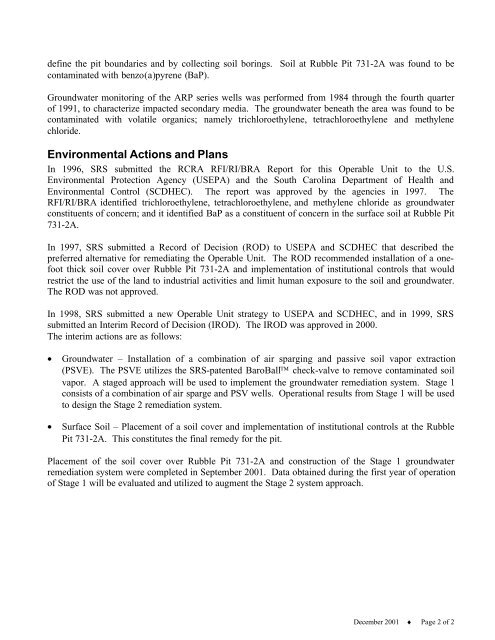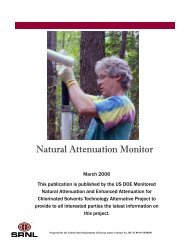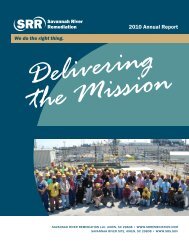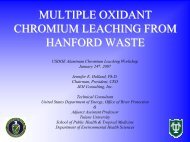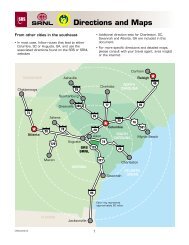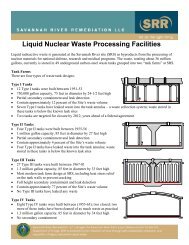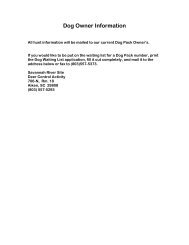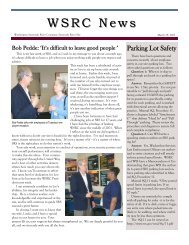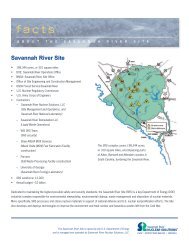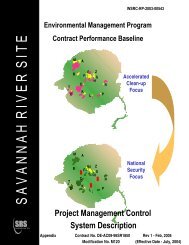A-Area Burning/Rubble and Rubble Pits - Savannah River Site
A-Area Burning/Rubble and Rubble Pits - Savannah River Site
A-Area Burning/Rubble and Rubble Pits - Savannah River Site
You also want an ePaper? Increase the reach of your titles
YUMPU automatically turns print PDFs into web optimized ePapers that Google loves.
define the pit boundaries <strong>and</strong> by collecting soil borings. Soil at <strong>Rubble</strong> Pit 731-2A was found to be<br />
contaminated with benzo(a)pyrene (BaP).<br />
Groundwater monitoring of the ARP series wells was performed from 1984 through the fourth quarter<br />
of 1991, to characterize impacted secondary media. The groundwater beneath the area was found to be<br />
contaminated with volatile organics; namely trichloroethylene, tetrachloroethylene <strong>and</strong> methylene<br />
chloride.<br />
Environmental Actions <strong>and</strong> Plans<br />
In 1996, SRS submitted the RCRA RFI/RI/BRA Report for this Operable Unit to the U.S.<br />
Environmental Protection Agency (USEPA) <strong>and</strong> the South Carolina Department of Health <strong>and</strong><br />
Environmental Control (SCDHEC). The report was approved by the agencies in 1997. The<br />
RFI/RI/BRA identified trichloroethylene, tetrachloroethylene, <strong>and</strong> methylene chloride as groundwater<br />
constituents of concern; <strong>and</strong> it identified BaP as a constituent of concern in the surface soil at <strong>Rubble</strong> Pit<br />
731-2A.<br />
In 1997, SRS submitted a Record of Decision (ROD) to USEPA <strong>and</strong> SCDHEC that described the<br />
preferred alternative for remediating the Operable Unit. The ROD recommended installation of a onefoot<br />
thick soil cover over <strong>Rubble</strong> Pit 731-2A <strong>and</strong> implementation of institutional controls that would<br />
restrict the use of the l<strong>and</strong> to industrial activities <strong>and</strong> limit human exposure to the soil <strong>and</strong> groundwater.<br />
The ROD was not approved.<br />
In 1998, SRS submitted a new Operable Unit strategy to USEPA <strong>and</strong> SCDHEC, <strong>and</strong> in 1999, SRS<br />
submitted an Interim Record of Decision (IROD). The IROD was approved in 2000.<br />
The interim actions are as follows:<br />
• Groundwater – Installation of a combination of air sparging <strong>and</strong> passive soil vapor extraction<br />
(PSVE). The PSVE utilizes the SRS-patented BaroBall check-valve to remove contaminated soil<br />
vapor. A staged approach will be used to implement the groundwater remediation system. Stage 1<br />
consists of a combination of air sparge <strong>and</strong> PSV wells. Operational results from Stage 1 will be used<br />
to design the Stage 2 remediation system.<br />
• Surface Soil – Placement of a soil cover <strong>and</strong> implementation of institutional controls at the <strong>Rubble</strong><br />
Pit 731-2A. This constitutes the final remedy for the pit.<br />
Placement of the soil cover over <strong>Rubble</strong> Pit 731-2A <strong>and</strong> construction of the Stage 1 groundwater<br />
remediation system were completed in September 2001. Data obtained during the first year of operation<br />
of Stage 1 will be evaluated <strong>and</strong> utilized to augment the Stage 2 system approach.<br />
December 2001 ♦ Page 2 of 2


